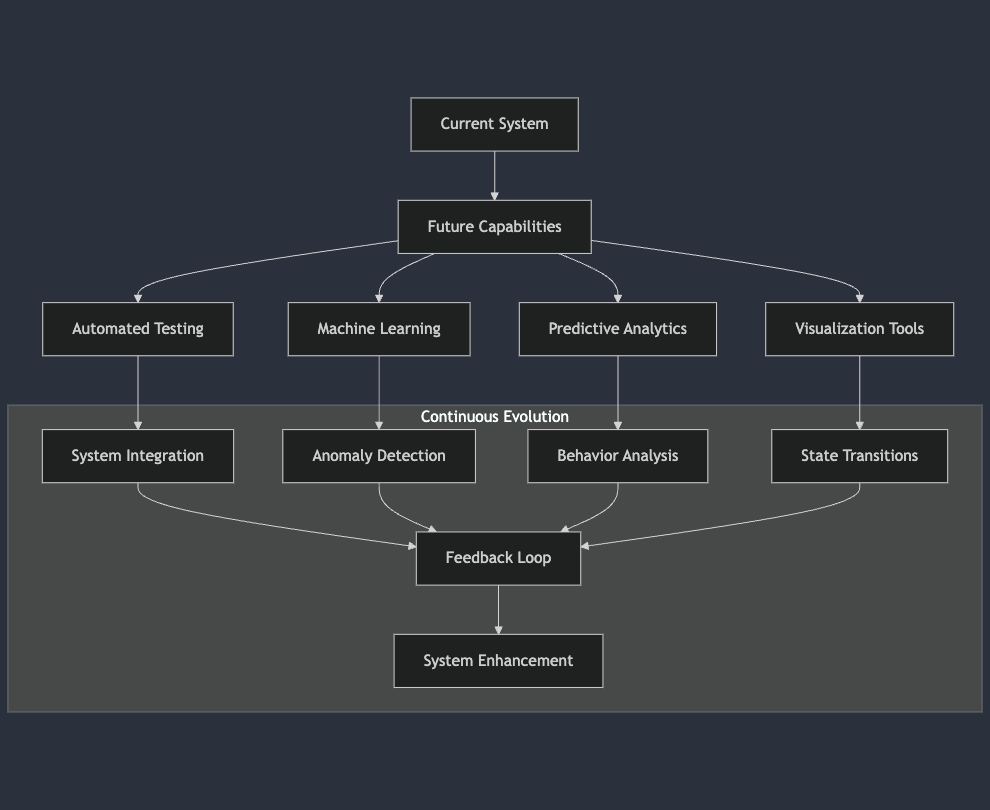Enhanced Debugging Capabilities in GRIDNET Core: A New Era of Blockchain Transparency
In a significant advancement for blockchain technology, we are excited to announce the integration of sophisticated debugging capabilities into GRIDNET Core. This update introduces a groundbreaking multi-state breakpoint system that fundamentally transforms how operators and developers interact with and understand blockchain operations.
At its heart, this enhancement addresses one of the most challenging aspects of distributed systems: real-time insight into transaction processing and state transitions. Traditional blockchain systems often operate as “black boxes,” where understanding the precise impact of transactions and state changes requires extensive post-processing and analysis. GRIDNET Core’s new breakpoint system changes this paradigm entirely.

The key innovation lies in its ability to freeze execution at critical moments, allowing operators to inspect not just the “what” but also the “how” and “why” of every state transition. This becomes particularly crucial in a system where each transaction can trigger complex cascades of GridScript instructions, potentially affecting multiple domains and state variables across the decentralized state machine.
This update represents more than just a debugging tool; it’s a fundamental shift in how we approach blockchain transparency and operational oversight. For the first time, operators can:
- Inspect transaction states before and after execution
- Compare expected versus actual outcomes in real-time
- Monitor state changes through the system’s Merkle Patricia Trie
- Track and validate state transitions during complex operations
- Proactively identify potential discrepancies before they impact the network
Perhaps most importantly, this system arrives at a crucial time in blockchain evolution, where the complexity of decentralized systems demands ever-greater transparency and control. As GRIDNET OS continues to evolve through hard forks and protocol upgrades, these debugging capabilities provide an essential safety net, ensuring that changes can be monitored, validated, and understood at the deepest technical level.
In the following sections, we’ll explore how this system works, its various components, and how it can be effectively utilized by both operators and developers. We’ll demonstrate how these new capabilities not only enhance system reliability but also contribute to the unprecedented levels of trust that make GRIDNET OS unique in the blockchain landscape.
Understanding Multi-State Breakpoints: The Foundation of Advanced Blockchain Debugging
The core innovation of GRIDNET’s new debugging system lies in its multi-state breakpoint architecture. Unlike traditional debugging systems that provide only snapshot views, GRIDNET’s implementation offers a comprehensive before-and-after analysis of every significant state transition within the blockchain.
Pre-Execution State Analysis
When a breakpoint is hit before transaction execution, operators gain access to what we call the “pre-execution perspective.” This perspective provides critical insights into:
- The current state of the system’s Merkle Patricia Trie
- Estimated ERG (computation unit) usage for the pending transaction
- Complete transaction metadata, including:
- Source domain and balance
- Destination domain (if specified) and current balance
- GridScript instructions to be executed
- Expected execution outcome based on block data

What makes this particularly powerful is that GRIDNET OS maintains the expected results of every transaction within its blockchain blocks. Each transaction’s Receipt contains not just the final result but also the complete processing log from its original execution. This means operators can compare expected outcomes with actual results in real-time.
Post-Execution Analysis
After transaction execution, the breakpoint system enters its second state, offering:
- Actual ERG usage compared to estimates
- Final execution status and result codes
- Detailed processing logs
- State changes in the Merkle Patricia Trie
- Balance updates for involved domains
- Execution discrepancies, if any
The system automatically detects and highlights any differences between pre and post-execution states. This is crucial for:
- Validating transaction processing
- Identifying unexpected state changes
- Debugging smart contract behavior
- Ensuring consistent execution across network updates
The Role of Perspectives
A unique feature of this implementation is its handling of “perspectives” – snapshots of the system’s state at specific points in time. Each breakpoint maintains awareness of:
- The current system perspective (encoded in the Merkle Patricia Trie)
- The transaction’s original execution perspective
- Any intermediate perspectives created during processing
By tracking these perspectives, operators can:
- Trace the exact path of state transitions
- Identify the precise point where expectations and reality might diverge
- Understand the cumulative impact of transaction processing
- Verify the consistency of state transitions
Types of Breakpoints: A Comprehensive Debugging Arsenal
The GRIDNET Core debugging system introduces three distinct categories of breakpoints, each designed to address specific operational needs in blockchain monitoring and development. Let’s explore each type and its unique capabilities.
Code Breakpoints: GridScript-Level Analysis
Code breakpoints represent the most granular level of debugging, operating directly at the GridScript instruction level. What makes these particularly powerful is the system’s ability to automatically decompile GridScript bytecode into readable metadata. This means operators can:
- Set breakpoints based on specific GridScript instructions
- Break on pattern matches within decompiled code
- Monitor specific function calls or state changes
- Track execution flow through smart contracts
For example, an operator might use:
chain -break code:'word#send'
to pause execution whenever a ‘send’ operation is encountered, or:
chain -break code:'find#mkdir test'
to break when specific patterns appear in the decompiled source code.
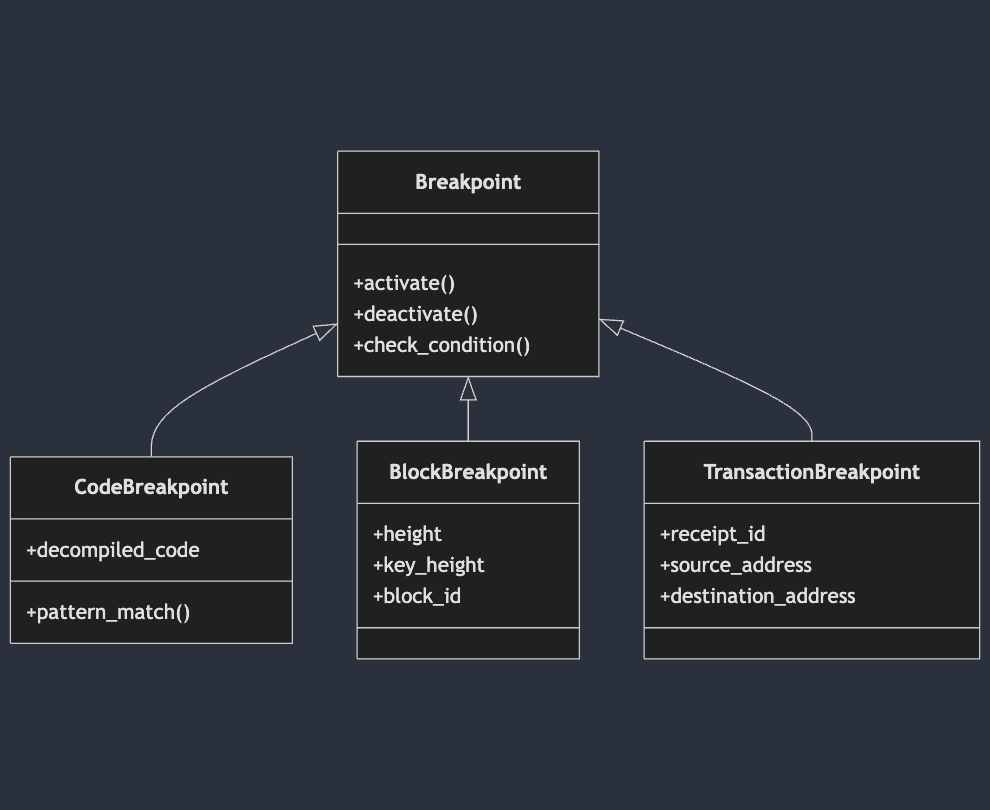
Block Breakpoints: Structural Monitoring
Block breakpoints provide a structural view of blockchain operations, operating at the block level. These can be set based on:
| Type | Command | Purpose |
|---|---|---|
| Block Height | chain -break block:1000 |
Break at specific blockchain heights |
| Key Block Height | chain -break key:100 |
Monitor key block transitions |
| Block ID | chain -break id:blockID |
Target specific blocks by their identifier |
These breakpoints are particularly valuable during hard forks or when monitoring network consensus transitions.
Transaction Breakpoints: State Transition Analysis
Transaction breakpoints offer the most sophisticated debugging capabilities, with three distinct targeting mechanisms:
- Receipt ID Based:
chain -break tx:receiptID
Targets specific transactions by their receipt identifier
- Source Based:
chain -break src:ADDRESS
Monitors all transactions originating from a specific domain
- Destination Based:
chain -break dst:ADDRESS
Tracks transactions targeting a specific domain
The power of transaction breakpoints lies in their dual-state nature. Each transaction breakpoint is triggered twice:
- Pre-execution: Showing anticipated state changes
- Post-execution: Revealing actual outcomes
Managing Breakpoint States
All breakpoint types support comprehensive state management through commands like:
-break on # Activate all breakpoints -break on:block # Activate block breakpoints -break on:tx # Activate transaction breakpoints -break off # Deactivate all -break stats # View breakpoint statistics
Transaction Processing Insights: A Deep Dive into GRIDNET’s State Machine
The introduction of multi-state breakpoints provides unprecedented visibility into GRIDNET’s transaction processing mechanics. This section explores how the new debugging system illuminates the journey of a transaction from submission to final state commitment.
Anatomy of a Transaction
Every transaction in GRIDNET OS represents a series of GridScript instructions that, when executed, transition the decentralized state machine from one valid state to another. These transitions are not simple value transfers but can involve complex state changes across multiple domains. With the new breakpoint system, we can now observe:
- The complete GridScript instruction set before execution
- Decompiled source code for enhanced readability
- Input parameters and their validation states
- Expected resource utilization (ERG estimates)
- Potential state changes and their implications

Pre-Execution Analysis
When a transaction triggers a pre-execution breakpoint, operators gain access to a comprehensive pre-execution report that includes:
- System State Perspective
- Current Merkle Patricia Trie root (base58-check encoded)
- Source domain’s current balance
- Destination domain’s current balance (if applicable)
- Transaction Context
- Whether the transaction is part of block formation or verification
- Key block height context
- Nonce values and their validation
- Execution Predictions
- Expected ERG consumption
- Anticipated state changes
- Initial Receipt data from blockchain
- Predicted execution outcome
Post-Execution Verification
The post-execution phase of the breakpoint system automatically compares actual results against expectations:
- State Change Analysis
- Actual vs. predicted Merkle Patricia Trie changes
- Balance updates verification
- ERG consumption accuracy
- Execution Validation
- Comparison with stored Receipt data
- Processing log verification
- State transition confirmation
- Discrepancy Detection
- Automatic highlighting of unexpected state changes
- Detailed comparison reports
- Performance metrics and resource usage
Real-world Impact
This level of insight is particularly valuable in several scenarios:
- Smart Contract Development
chain -break src:CONTRACT_ADDRESS
Allows developers to monitor their contract’s behavior in real-time.
- Hard Fork Validation
chain -break block:FORK_HEIGHT
Ensures consistent state transitions during network upgrades.
- Security Monitoring
chain -break dst:TREASURY_ADDRESS
Enables proactive monitoring of critical system addresses.
The system has already proven invaluable in detecting subtle variations in transaction processing that might arise from:
- Network upgrades
- Protocol changes
- Implementation optimizations
- State machine evolution
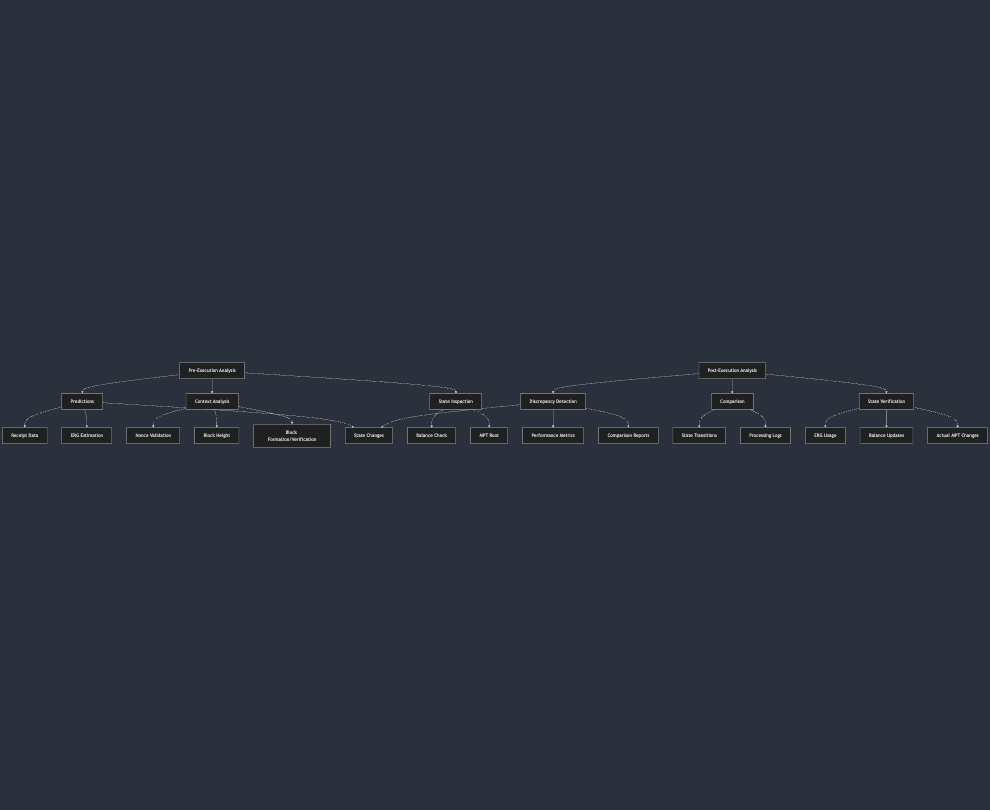
Operator’s Guide to Breakpoint Management
GRIDNET Core provides an intuitive and powerful interface for managing breakpoints through its chain utility. This guide demonstrates how operators can effectively utilize these debugging capabilities in their day-to-day operations.
Basic Breakpoint Syntax
All breakpoint operations follow a consistent format:
chain -break [TYPE:VALUE]
The system supports three fundamental categories of breakpoints, each serving a distinct purpose:
Transaction Breakpoints
chain -break tx:receipt_ID # Break on specific transaction chain -break src:ADDRESS # Break on transactions from address chain -break dst:ADDRESS # Break on transactions to destination
Transaction breakpoints are particularly useful when monitoring specific accounts or tracking transaction flows. For example, an operator investigating suspicious activity might set a source-based breakpoint to monitor all transactions originating from a particular domain.
Block Breakpoints
chain -break block:1000 # Break at block height 1000 chain -break key:500 # Break at key block height 500 chain -break id:BLOCKID # Break at specific block ID
Block breakpoints enable systematic inspection of blockchain progression. They’re invaluable during hard forks or when verifying network consistency at specific heights.
Code Breakpoints
chain -break code:'word#send' # Break at word 'send' in GridScript chain -break code:'find#mkdir test' # Break on specific code pattern
Code breakpoints leverage GRIDNET’s automatic decompilation capabilities, allowing operators to break on specific GridScript patterns or commands.
Breakpoint Management Commands
| Category | Command | Purpose |
|---|---|---|
| Listing and Statistics | chain -break list |
Show all breakpoints |
chain -break stats |
Display breakpoint statistics | |
| Activation Control | chain -break on |
Activate all breakpoints |
chain -break on:block |
Activate block breakpoints | |
chain -break on:tx |
Activate transaction breakpoints | |
chain -break off |
Deactivate all breakpoints | |
| Cleanup | chain -break clear |
Remove all breakpoints |
Working with Breakpoint Data
When a breakpoint is hit, the system provides detailed contextual information:
- Pre-execution State:
- Current system perspective (Merkle Patricia Trie state)
- Expected transaction outcomes
- Source and destination balances
- Estimated ERG usage
- Post-execution State:
- Actual execution results
- State changes
- Balance updates
- Processing logs
- Any discrepancies from expected behavior
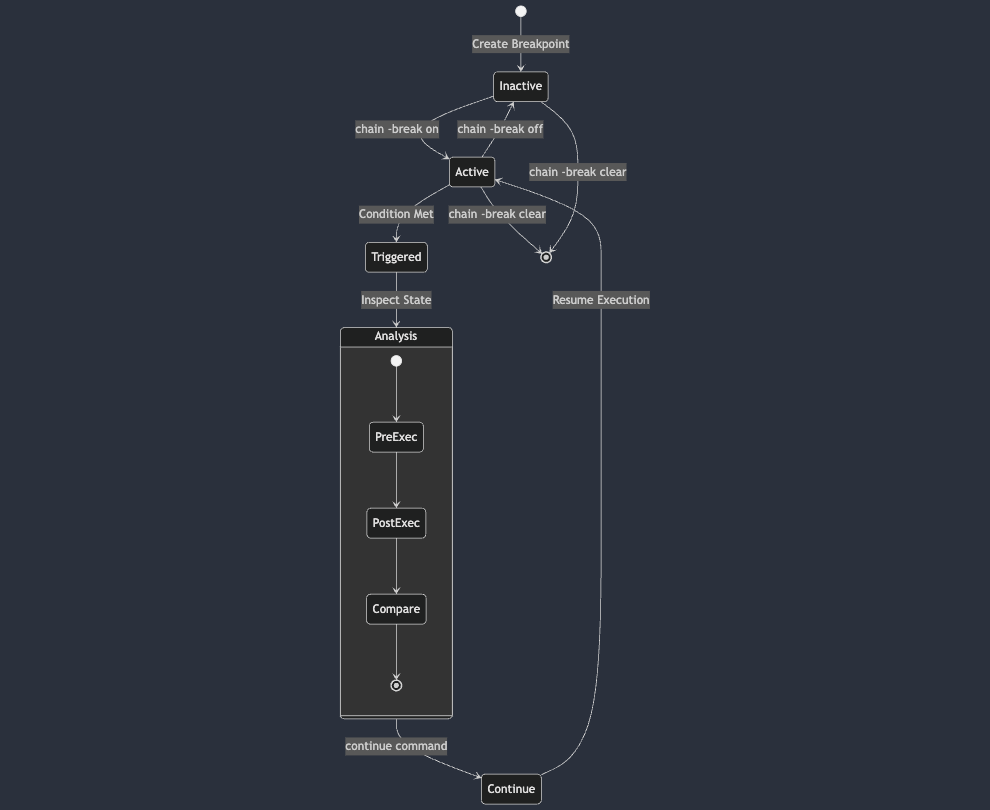
Interactive Debugging Commands
During a breakpoint pause, operators can:
- Continue execution with
continue - Disable specific breakpoints with
skip N - Disable all current breakpoints with
skip all - Review detailed state information
- Compare pre and post-execution states
Best Practices
- Targeted Breaking:
Use specific breakpoints rather than broad conditions to minimize unnecessary interruptions. - State Monitoring:
Leverage pre/post execution states to verify transaction behavior matches expectations. - Performance Considerations:
Deactivate unnecessary breakpoints during normal operation to maintain optimal system performance. - Documentation:
Maintain logs of breakpoint findings, especially during network upgrades or when investigating anomalies.
Hard Fork Support and System Evolution: A Breakthrough in Protocol Update Management
In the rapidly evolving landscape of blockchain technology, GRIDNET’s new breakpoint system serves as a critical tool for managing one of the most challenging aspects of decentralized networks: protocol updates and hard forks. The integration of multi-state breakpoints has revolutionized how we approach and validate system-wide changes.
Understanding Hard Fork Complexities
Hard forks in GRIDNET OS involve not just protocol changes but often modifications to how GridScript instructions are interpreted and executed. These changes can have subtle yet significant impacts on:
- Transaction processing logic
- State transition rules
- Smart contract execution
- Resource (ERG) calculations
- Domain interactions
The new breakpoint system directly addresses these challenges by providing real-time insight into execution changes.
Pre-Fork Validation
Before implementing hard fork changes, operators can now:
- Set breakpoints at critical state transitions
- Compare execution paths between current and proposed implementations
- Identify potential processing discrepancies
- Validate ERG usage calculations
- Verify state consistency across transitions
This pre-emptive analysis helps prevent unexpected behaviors that might only become apparent after a fork is activated.
Post-Fork Monitoring
The true power of the breakpoint system becomes evident during the critical period following a hard fork:
Pre-Fork Transaction Result -------------------------- Receipt ID: RX123... Status: Valid ERG Used: 1000 State Change: [Previous Perspective] Post-Fork Execution ------------------ Status: Valid (Modified Logic) ERG Used: 950 State Change: [New Perspective] Divergence Detected: ERG Calculation
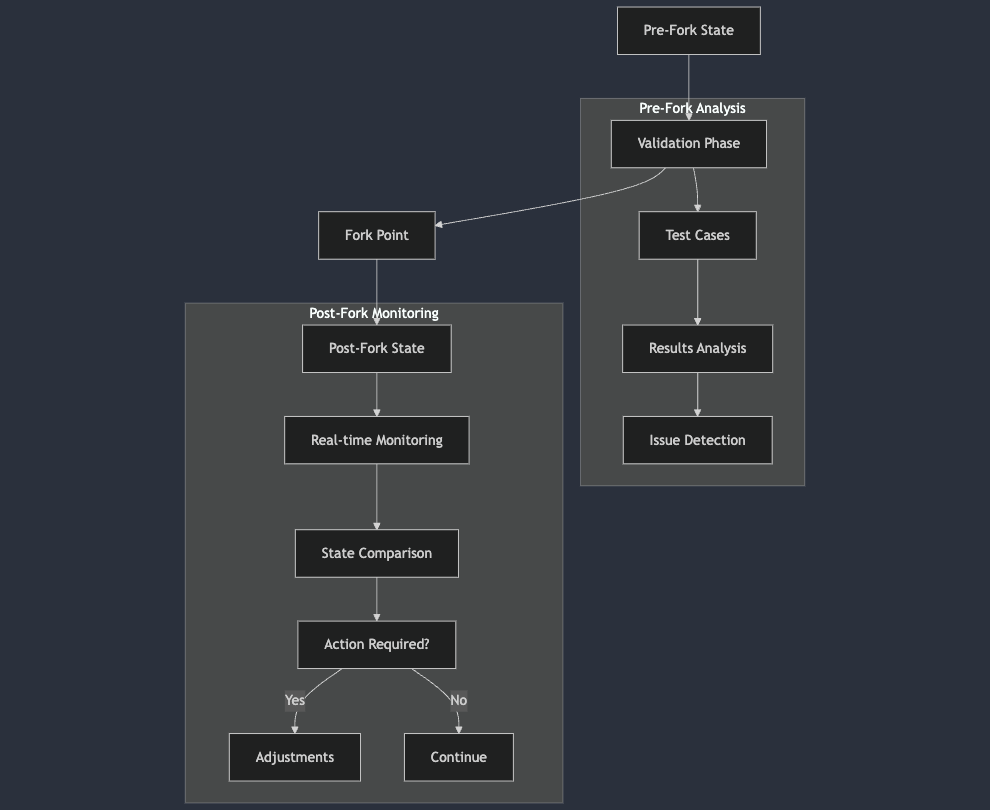
Operators can:
- Monitor transactions that behave differently under new rules
- Track state transitions that diverge from previous implementations
- Verify that changes are applied consistently across the network
- Identify edge cases not caught during testing
Automated Discrepancy Detection
The system automatically flags and categorizes processing changes:
- Execution path variations
- State transition differences
- ERG usage modifications
- Smart contract behavior changes
- Receipt validation discrepancies
Each flagged difference includes detailed context about both the original and new execution environments, enabling operators to make informed decisions about the impact of changes.
Future-Proofing Protocol Evolution
This infrastructure doesn’t just support current hard forks—it creates a foundation for future protocol evolution:
- Historical execution data can be analyzed to inform future changes
- Impact assessments become more accurate and comprehensive
- Testing scenarios can be derived from real-world edge cases
- Protocol updates can be validated against actual network behavior
Living Implementation Support
As GRIDNET OS continues to evolve, this breakpoint system ensures that:
- Changes to GridScript interpretation can be thoroughly validated
- New features can be safely integrated
- Backward compatibility can be verified
- Network stability is maintained during transitions
Technical Implementation Details: Inside GRIDNET’s Advanced Debugging Architecture
Multi-Level Cache and Meta-Data Generation
GRIDNET’s debugging system is built upon a sophisticated multi-level caching architecture that optimizes performance while maintaining real-time debugging capabilities. At its core, the system employs three distinct caching layers:
- Immediate Meta-Data Cache
- Stores pre-computed transaction and block metadata
- Generated during initial block processing
- Contains decompiled GridScript representations
- Maintains relationship mappings between transactions and blocks
- Optimized for quick breakpoint condition evaluation
- Domain Meta-Data Cache
- Caches current state of domains
- Pre-computed balances and transaction histories
- Updated synchronously with state changes
- Used for instant state comparisons during debugging
- Block Meta-Data Cache
- Stores decompiled representations of transactions
- Maintains block relationship trees
- Caches chain-proof validations
- Optimizes block-based breakpoint triggering
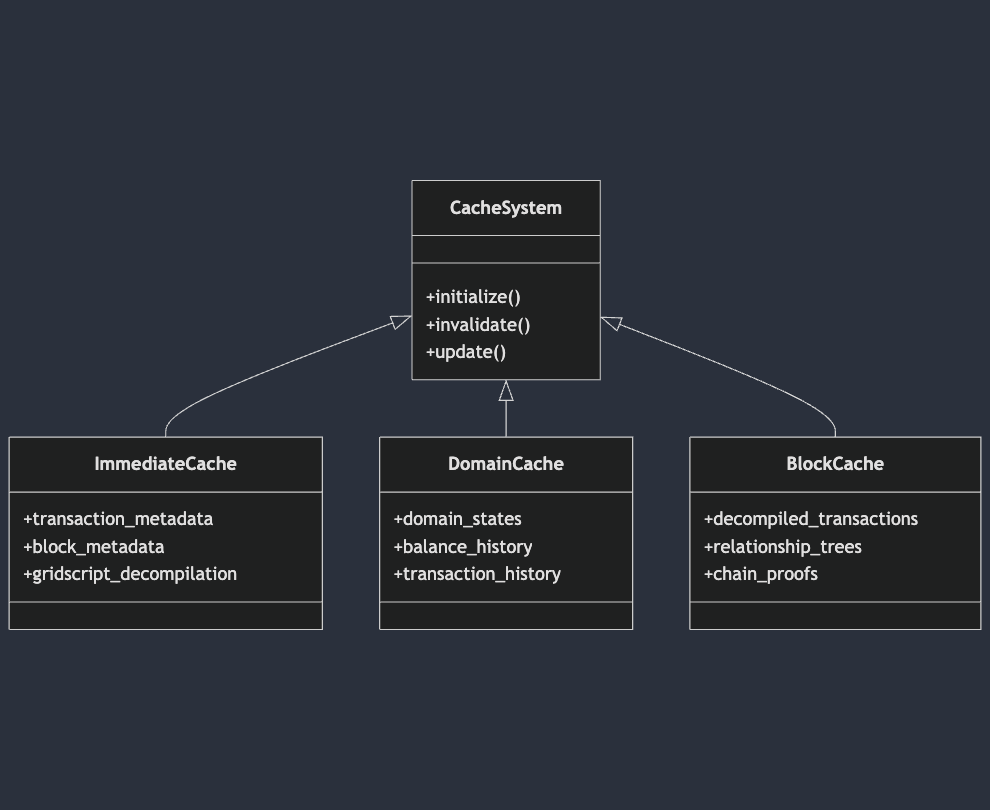
GridScript Decompilation and Meta-Data Generation
The system’s ability to trigger breakpoints based on GridScript content relies on an advanced decompilation pipeline:
GridScript Byte Code
↓
Decompilation Engine
↓
Abstract Syntax Tree (AST)
↓
Pattern Recognition Layer
↓
Meta-Data Generation
↓
Breakpoint Trigger System
When transactions are first encountered, their GridScript byte code is automatically decompiled to generate searchable meta-data. This process:
- Converts byte code to human-readable form
- Extracts key operations and patterns
- Identifies potential points of interest
- Creates indexed lookup tables for quick matching
Breakpoint Trigger Mechanics
The system employs a two-phase breakpoint evaluation:
1. Pre-Execution Phase
Transaction Received
↓
Meta-Data Generated
↓
Pattern Matching
↓
Pre-Execution State Capture
↓
Breakpoint Evaluation
↓
Developer/Operator Notification
2. Post-Execution Phase
Execution Complete
↓
State Change Detection
↓
Meta-Data Update
↓
State Comparison
↓
Breakpoint Re-Evaluation
↓
Change Report Generation
Performance Optimizations
To maintain system performance while providing comprehensive debugging capabilities:
- Lazy Meta-Data Generation
- Meta-data is only generated for blocks/transactions with active breakpoints
- Uses smart caching to avoid redundant decompilation
- Implements reference counting for cached meta-data
- Incremental State Tracking
- Only tracks changed state components
- Uses differential updates for state comparisons
- Maintains minimal memory footprint
- Intelligent Cache Invalidation
- Time-based cache expiration
- Usage-based retention policies
- Priority-based cache management
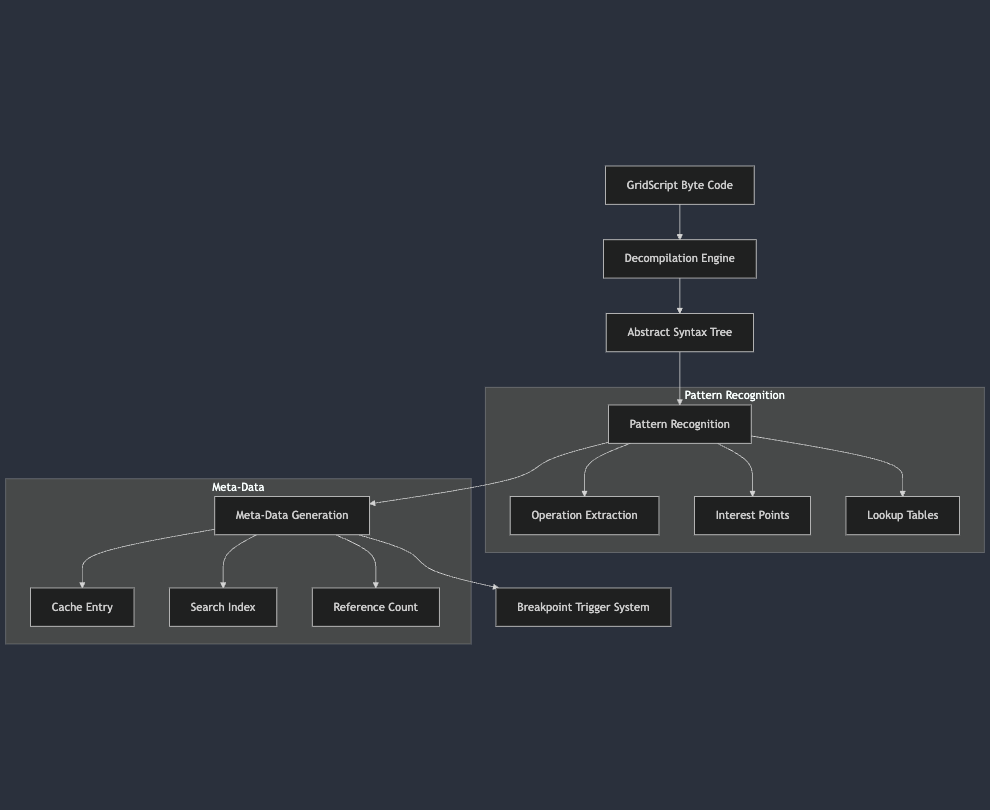
Breakpoint Condition Matching
The system supports complex breakpoint conditions through a layered matching system:
Condition Layer 1: Basic Matching - Transaction IDs - Block Heights - Domain Addresses Condition Layer 2: Pattern Matching - GridScript Patterns - Operation Sequences - State Change Patterns Condition Layer 3: Composite Conditions - Multiple Condition Matching - State-Based Conditions - Time-Window Conditions
Each layer can trigger independently or in combination with others, providing maximum flexibility for debugging scenarios.
Integration with Chain-Proof System
The debugging infrastructure is tightly integrated with GRIDNET’s Chain-Proof system:
- Verified Chain Integration
- Breakpoints can monitor verified chain transitions
- Provides historical context for state changes
- Enables cross-reference with block verification
- Heaviest Chain Monitoring
- Monitors potential chain reorganizations
- Tracks state transitions during chain switches
- Provides early warning for consensus issues
Accountability and Trust: The Cornerstone of GRIDNET’s Enhanced Transparency
In an era where blockchain technology promises transparency but often falls short in delivering actionable insights, GRIDNET’s new breakpoint system establishes unprecedented levels of accountability. This isn’t just about debugging—it’s about fostering trust through complete system observability.
Beyond Traditional Blockchain Transparency
While conventional blockchains offer transaction visibility, GRIDNET’s breakpoint system provides something far more valuable: operational transparency. Operators and stakeholders can now:
- Observe transaction processing in real-time
- Verify execution paths step by step
- Compare expected versus actual outcomes
- Track state changes with microsecond precision
- Validate resource utilization
Trust Through Verification
The system reinforces trust by making every aspect of transaction processing observable and verifiable:
Transaction Execution Verification -------------------------------- ✓ Pre-execution state validated ✓ GridScript instructions verified ✓ Resource allocation confirmed ✓ State transitions tracked ✓ Post-execution state matched
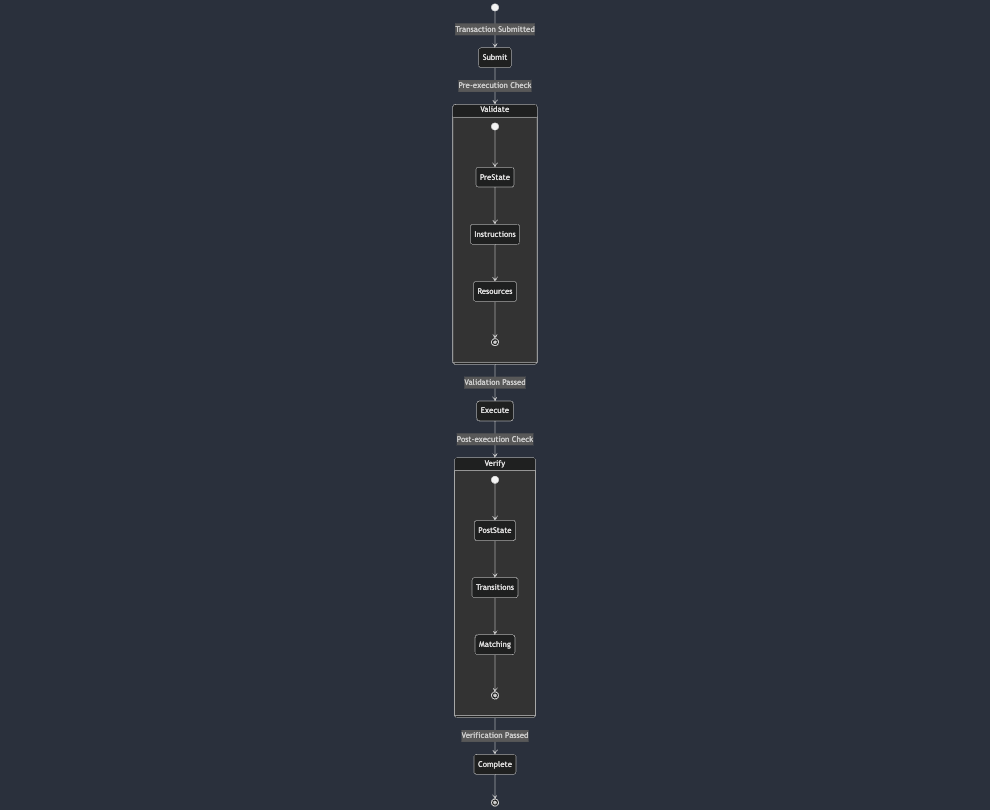
When discrepancies occur, they’re not just detected—they’re explained. Each variance generates a comprehensive report detailing:
- The exact point of divergence
- State differences
- Execution context
- Applied rules
- Resource utilization
Operator Empowerment
This new level of insight transforms how operators interact with the network:
- Proactive Monitoring
- Set breakpoints at critical state transitions
- Monitor specific transaction patterns
- Track domain interactions
- Validate smart contract execution
- Real-time Validation
- Verify transaction processing integrity
- Confirm resource calculations
- Ensure fair system usage
- Validate state transitions
- Historical Analysis
- Review execution patterns
- Analyze performance metrics
- Track system evolution
- Identify optimization opportunities
Building Network-Wide Trust
The impact extends beyond individual transactions to create network-wide accountability:
| Aspect | Benefit |
|---|---|
| Transparent Operations | Every state change is traceable and verifiable |
| Verifiable Execution | Processing rules are consistently applied and observable |
| Resource Fairness | ERG usage is transparent and accurately tracked |
| State Integrity | Changes to the Merkle Patricia Trie are fully auditable |
Customer and Developer Confidence
This enhanced accountability directly translates to increased confidence for:
- Application Developers
- Debug smart contracts effectively
- Validate execution assumptions
- Optimize resource usage
- Ensure consistent behavior
- Service Providers
- Verify transaction processing
- Monitor system interactions
- Ensure service reliability
- Track resource utilization
- End Users
- Trust transaction outcomes
- Understand processing results
- Verify fair treatment
- Access transparent records
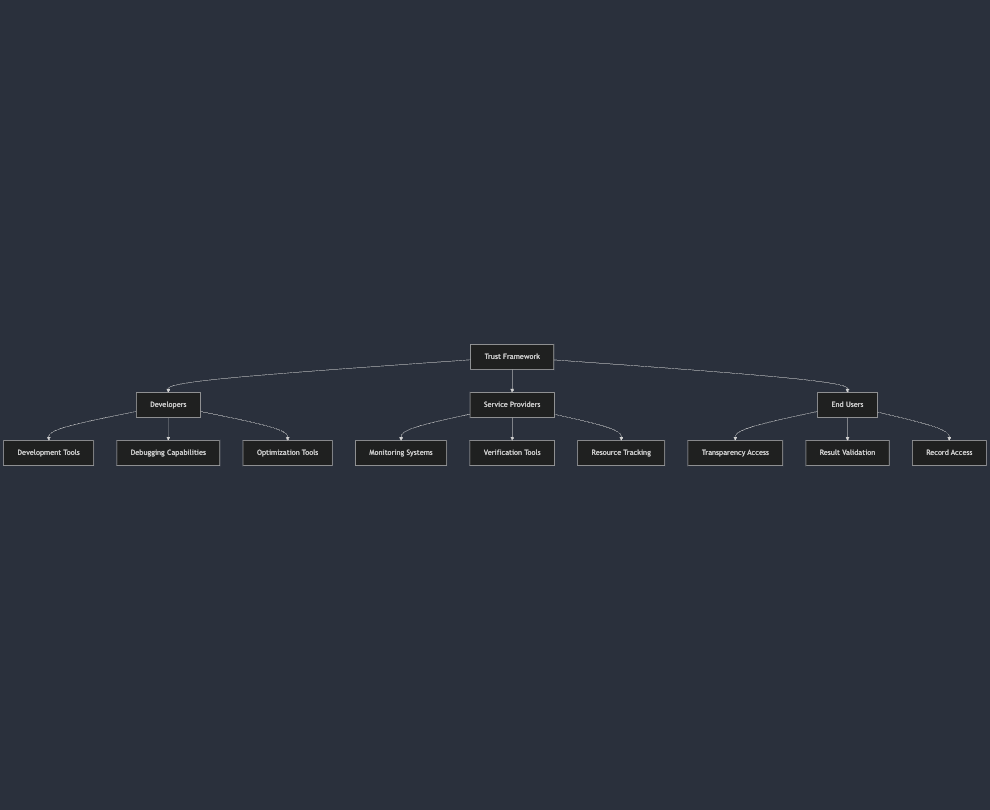
The Future of Blockchain Accountability
GRIDNET’s breakpoint system sets a new standard for blockchain transparency. It demonstrates that true accountability comes not just from recording transactions, but from making every aspect of their processing observable, understandable, and verifiable.
This level of transparency:
- Encourages network participation
- Facilitates rapid problem resolution
- Supports continuous improvement
- Builds lasting trust
Conclusion and Future Implications: Shaping the Future of Blockchain Debugging
Transformative Impact
The introduction of multi-state breakpoint mechanics in GRIDNET Core represents more than just a technical advancement—it marks a fundamental shift in how we approach blockchain transparency and operational oversight. By bridging the gap between transaction execution and system understanding, we’ve created a foundation for unprecedented levels of blockchain reliability and trust.
Current Achievements
The new debugging system has already demonstrated significant benefits:
- Real-time insight into transaction processing
- Early detection of potential processing discrepancies
- Streamlined hard fork transitions
- Enhanced operator confidence in system behavior
- Accelerated smart contract development and testing
- Improved system maintenance capabilities
Ecosystem Benefits
For different stakeholders, these capabilities translate into tangible advantages:
| Stakeholder | Benefits |
|---|---|
| For Developers |
|
| For Operators |
|
| For the Network |
|
Looking Forward
As GRIDNET OS continues to evolve, these debugging capabilities will play a crucial role in:
- Protocol Evolution
- Supporting future protocol upgrades
- Validating new features
- Ensuring backward compatibility
- Maintaining network stability
- System Scalability
- Monitoring performance at scale
- Identifying optimization opportunities
- Managing growing network complexity
- Ensuring consistent behavior across network expansion
- Security Enhancement
- Early detection of anomalies
- Improved audit capabilities
- Enhanced threat response
- Better security validation
Native Debugger Integration: Bridging GRIDNET Core and Visual Studio
GRIDNET Core’s breakpoint system has been specifically designed to seamlessly integrate with native debugging tools, particularly Microsoft Visual Studio. This integration provides developers with unprecedented control over the debugging process while maintaining system performance.
How It Works
- Performance-First Approach
- GRIDNET Core continues running at full speed with internal breakpoints active
- No performance impact until a breakpoint condition is met
- Zero-overhead monitoring of transaction and block states
- Smart Debugger Attachment
- Core internally monitors for breakpoint conditions
- When hit, Core signals the debugging host process
- Visual Studio automatically attaches to the process
- Developer gains full debugging capabilities at the exact moment of interest
- Contextual Debug State
- Full call stack preservation
- Complete memory state access
- Transaction context available in debug watches
- Access to all Core internal structures
Developer Benefits
- Zero-impact debugging until needed
- No need for constant debugger attachment
- Precise breakpoint targeting
- Full access to Core internals when needed
- Preservation of production performance characteristics
Sample GRIDNET Core Development Workflow
Here you may see how we’ve employed GRIDNET Core internal breakpoints during development.
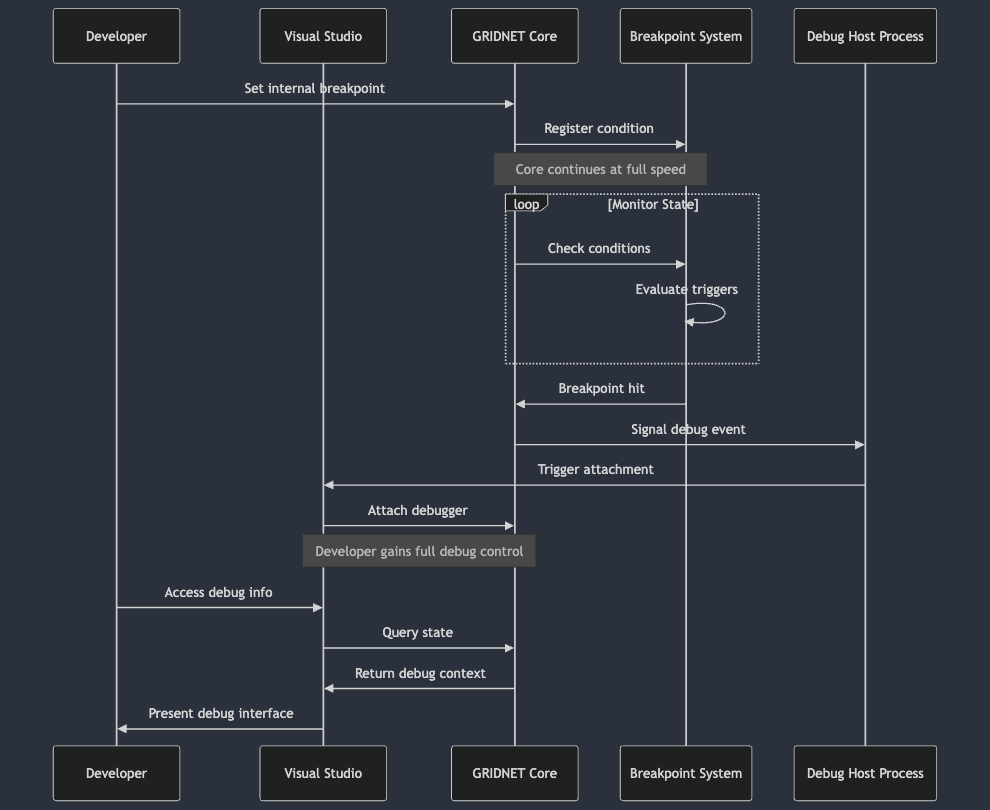
Now moving on to visualise how third party developers may use breakpoints to debug applications and GridScript smart-contracts on their own:
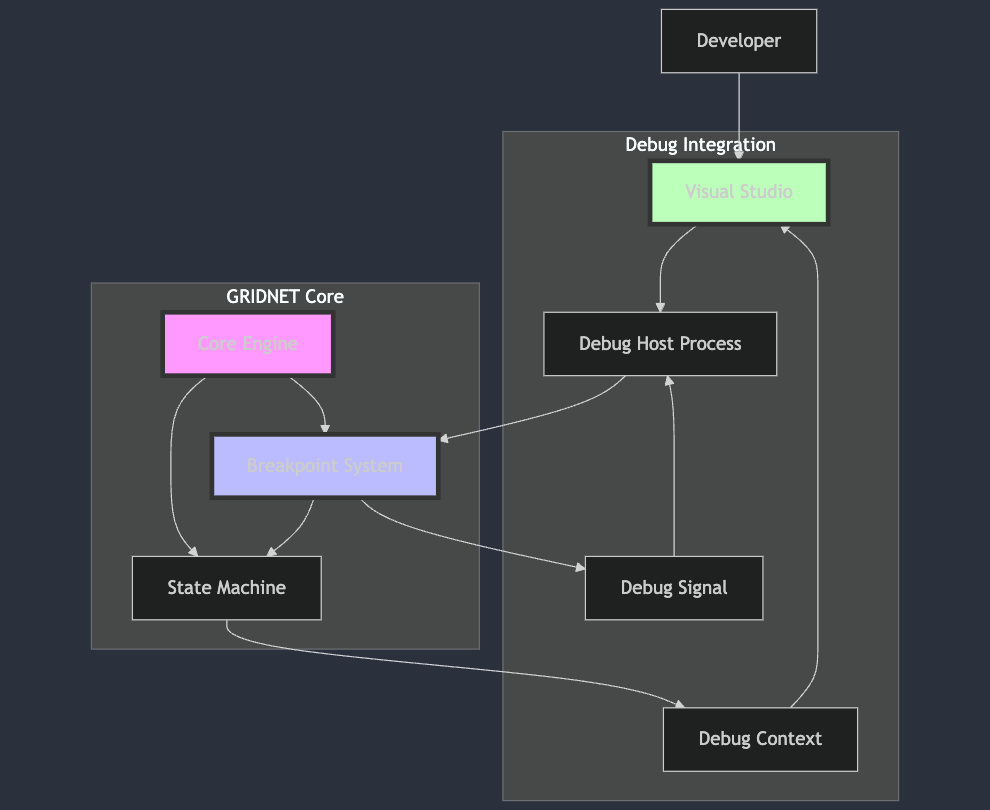
Vision for the Future
We envision this system as the foundation for even more advanced capabilities:
- Integration with automated testing frameworks
- Machine learning-based anomaly detection
- Predictive system behavior analysis
- Advanced visualization tools for state transitions
Call to Action
We encourage all GRIDNET operators and developers to:
- Familiarize themselves with these new debugging capabilities
- Integrate breakpoints into their operational procedures
- Provide feedback on additional debugging needs
- Participate in the continued evolution of these tools
The introduction of multi-state breakpoints is not just an end point—it’s the beginning of a new era in blockchain transparency and reliability. As we move forward, these capabilities will continue to evolve, ensuring that GRIDNET remains at the forefront of blockchain technology, providing the tools needed for confident, secure, and efficient blockchain operations.
Together, we’re building not just a more debuggable blockchain, but a more trustworthy and transparent decentralized future.
